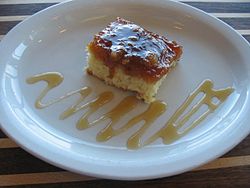Top Qs
Timeline
Chat
Perspective
Pouding chômeur
Québécois dessert From Wikipedia, the free encyclopedia
Remove ads
Pouding chômeur ("unemployed man's pudding", often translated idiomatically as "poor man's pudding") is a dessert that was created during the early years of the Great Depression[1] in Quebec, Canada. It typically involves a bread pudding covered in a mixture with a syrup, usually maple syrup and cream.[2] Today, it is casually served as a regional dessert, perhaps being a bit more popular during the saison des sucres, when maple sap is collected and processed and is usually part of the offerings during a meal at a sugar shack, but it is not specifically a maple dessert.
In Australia, New Zealand, and parts of the United Kingdom, a similar dessert known as "self saucing pudding" (or often just called pudding) exists, although it is now more commonly sold in baking mix packages alongside other cakes, rather than being prepared at home.[3]
Remove ads
Description
The pouding chômeur is a basic cake batter onto which a hot syrup, typically maple or caramel is poured before baking. The cake then rises through the liquid which settles at the bottom of the pan, mixing with the batter and creating a distinct layer at the bottom of the dish. The syrup or caramel can be made from brown sugar, white sugar, maple syrup or a combination of these.
During the worst of the Depression, stale bread was used in lieu of cake batter.[citation needed]
Remove ads
Linguistic variations
The dessert is also sometimes called pouding du chômeur or pouding au chômeur and is sometimes written using the formal English word pudding.
See also
References
Wikiwand - on
Seamless Wikipedia browsing. On steroids.
Remove ads

